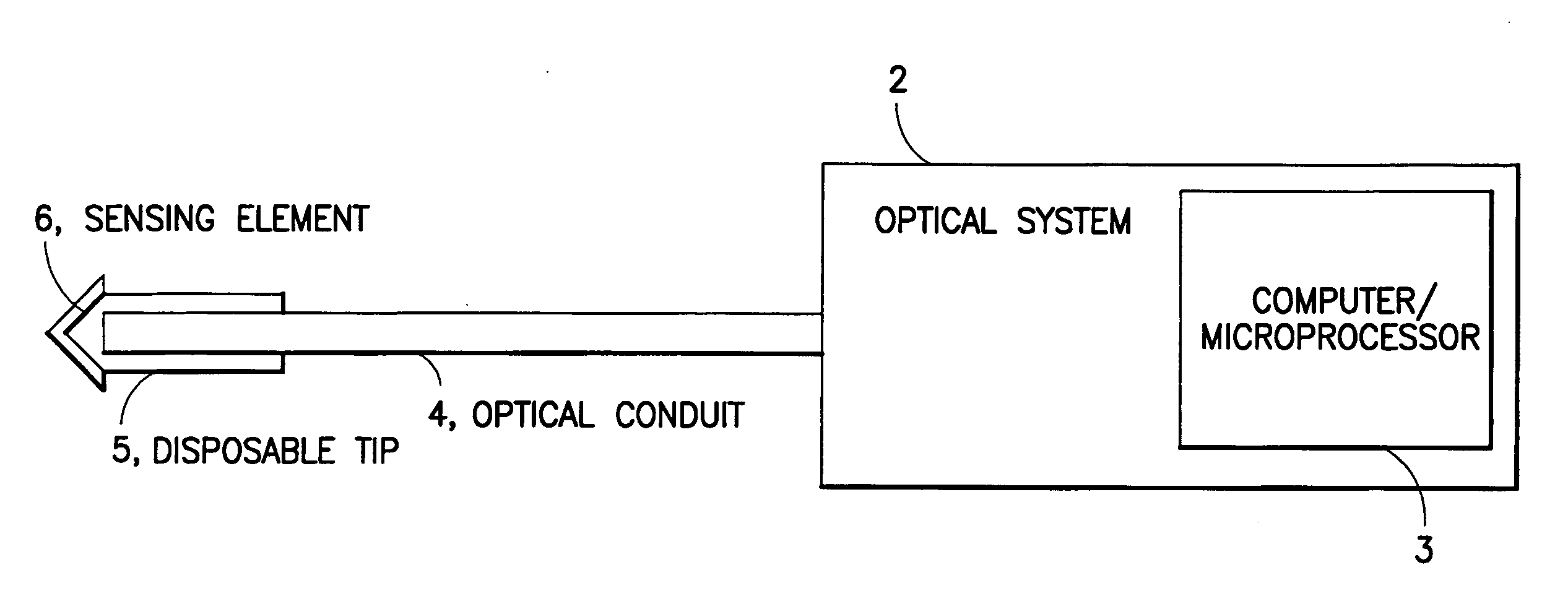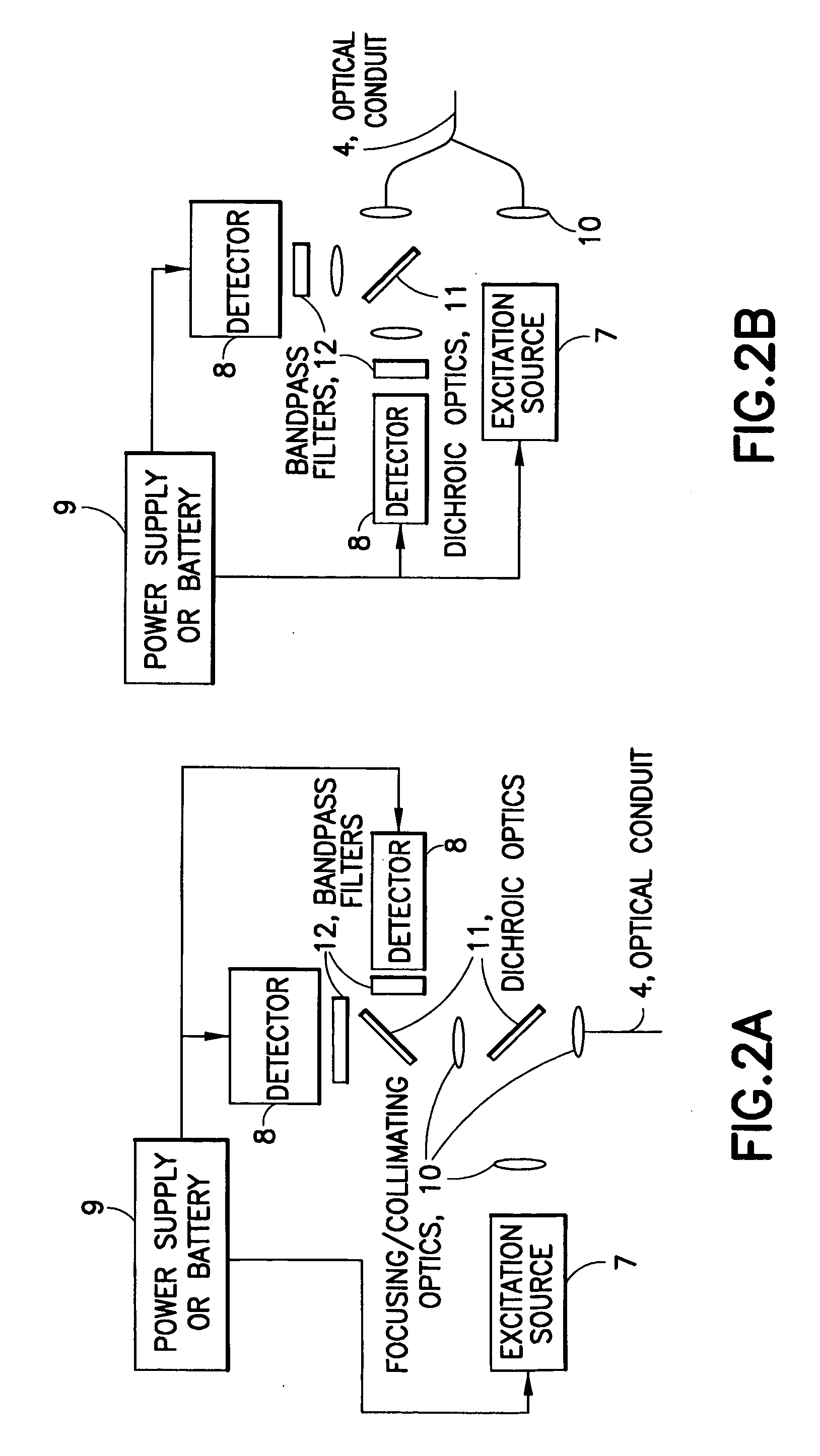Fiber optic device for sensing analytes and method of making same
- Summary
- Abstract
- Description
- Claims
- Application Information
AI Technical Summary
Benefits of technology
Problems solved by technology
Method used
Image
Examples
example 1
[0054] According to one embodiment of the present invention, glucose galactose binding protein (GGBP) was used with a triple mutation including a cysteine substituted for an glutamic acid at position 149, an arginine substituted for an alanine at position 213 and a serine substituted for leucine at position 238 (E149C / A213R / L238S). The protein was labeled at the 149 position with N,N′-dimethyl-N-(iodoacetyl)-N′-(7-nitrobenz-2-oxa-1,3-diazol-4-yl)ethylenediamine (IANBD amide)oxy. This mutated GGBP (E149C / A213R / L238S) is specific for glucose, and the reporter group undergoes a fluorescence intensity change in response to glucose binding.
[0055] A multicoated or multilayer matrix was prepared as follows. A core matrix was formed by mixing 1 part luminescent or dye-labeled binding protein (15 uM in PBS buffer, pH 7.4, prepared as described in PCT[US03 / 00203) with 2 to 4 parts 3 wt % alginate (v / v) in a scintillation vial and vortexing at slow speed. 3 mL of the resulting protein-alginat...
example 2
[0058] In another embodiment, the binding protein was glucose galactose binding protein (GGBP), with a cysteine substituted for an glutamic acid at position 149, an arginine substituted for an alanine at position 213 and a serine substituted for leucine at position 238 (E149C / A213R / L238S). The protein was labeled at the 149 position with N,N′-dimethyl-N-(iodoacetyl)-N′-(7-nitrobenz-2-oxa-,3-diazol-4-yl)ethylenediamine (IANBD amide). The biosensor was prepared by inserting the tip of a 400 micron core diameter fiber into a short piece of catheter tubing, and allowing the catheter tubing to overhang the fiber tip by 0.1-1 mm. The fiber comprised a silica core, silica cladding, and polyimide buffer. The fiber diameter was 400 / 440 / 470 microns, where the slashes denote diameters measured from the core cladding buffer exteriors.
[0059] The immobilization matrix was a crosslinked alginate-based hydrogel, prepared by covalently crosslinking Pronova™ UP LVG alginate through the carboxyls wit...
example 3
[0063] In another embodiment of the present invention, a biosensor was formed by covalent attachment of a thin film to the surface of an optical fiber. The binding protein was glucose galactose binding protein (GGBP), with a cysteine substituted for a glutamic acid at position 149, an arginine substituted for an alanine at position 213 and a serine substituted for leucine at position 238 (E149C / A213R / L238S). The protein was labeled at the 149 position with N,N′-dimethyl-N-(iodoacetyl)-N′-(7-nitrobenz-2-oxa-1,3-diazol-3-yl)ethylenediamine (IANBD amide).
[0064] The biosensor was prepared by covalent attachment of an alginate matrix to the amine-functionalized surface of a silica fiber. The fiber comprised a silica core, silica cladding, and polyimide buffer. The fiber diameter was 400 / 440 / 470 microns, where the slashes denote diameters measured from the core / cladding / buffer exteriors.
[0065] The polyimide buffer was removed from the tip of the optical fiber by exposing the last few mi...
PUM
 Login to View More
Login to View More Abstract
Description
Claims
Application Information
 Login to View More
Login to View More - R&D
- Intellectual Property
- Life Sciences
- Materials
- Tech Scout
- Unparalleled Data Quality
- Higher Quality Content
- 60% Fewer Hallucinations
Browse by: Latest US Patents, China's latest patents, Technical Efficacy Thesaurus, Application Domain, Technology Topic, Popular Technical Reports.
© 2025 PatSnap. All rights reserved.Legal|Privacy policy|Modern Slavery Act Transparency Statement|Sitemap|About US| Contact US: help@patsnap.com



